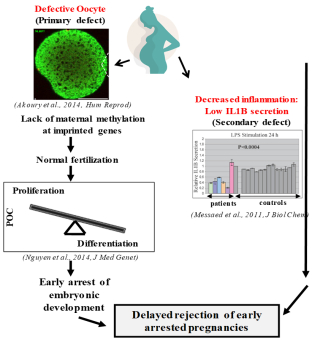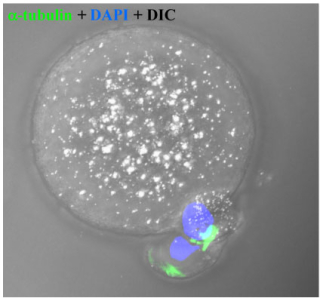NLRP7 | MEI1, TOP6BL, and REC114 | Novel genes for fetal loss
NLRP7

Mechanism of recurrent hydatidiform moles caused by NLRP7 mutations
In 2006, our group discovered that bi-allelic mutations in
NLRP7 are responsible for recurrent molar pregnancies.
NLRP7 is a maternal-effect gene that is required primarily in the oocyte. Oocytes from patients with recessive mutations in
NLRP7 fertilize normally and the resulting molar conceptions have diploid biparental genomes. However, in these molar tissues, all imprinted genes lack maternal methylation marks that are normally established during oogenesis. In these molar conceptions, tissues differentiation is impaired and trophoblastic proliferation exacerbated. In addition, the patients have compromised inflammatory response; consequently, they retain these defective pregnancies, in which embryonic development had arrested earlier, until ~12 weeks of gestation. It is the delayed retention of these pregnancies, in which fetal vessels did not differentiate, that contributes to the molar phenotype. We are currently investigating more precisely the role of NLRP7 in cellular differentiation and proliferation in collaboration with Dr. Brian Cox (University of Toronto).
MEI1, TOP6BL, and REC114

An empty oocyte from a Mei1-null female mouse that has lost its DNA and meiotic spindles into the two 1st polar bodies.
Recently, in collaboration with Dr. Jacek Majewski, we discovered that recessive mutations in
MEI1,
TOP6BL, and
REC114 genes are responsible for recurrent androgenetic hydatidiform moles. In addition to the moles, the patients and their siblings had also recurrent miscarriages and female and/or male infertility. In collaboration with Dr. Teruko Taketo, we investigated the occurrence of androgenetic conceptions in
Mei1-null females and found that these mice produce empty oocytes by extruding all the chromosomes with meiotic spindles into the first polar body. We also found that these mice produce androgenetic zygotes in ~5% of their conceptions. The three genes have known roles in double-strand breaks formation and we are currently exploring further their roles in knockout mice and the involvement of these genes in various forms of fetal loss in humans.
Novel genes for fetal loss
We are also working on the identification of more genes causing recurrent hydatidiform moles, miscarriages, and infertility, with the collaboration of many clinicians. To achieve this goal, we recruit patients with any of the following conditions:
- at least two molar pregnancies (all histological and genotypic types),
- at least five miscarriages and no live birth,
- women with at least 5 years of infertility and no live birth.
If you had had any of the above conditions and you wish to participate in our study, please contact us at rrw [at] muhc.mcgill.ca.

